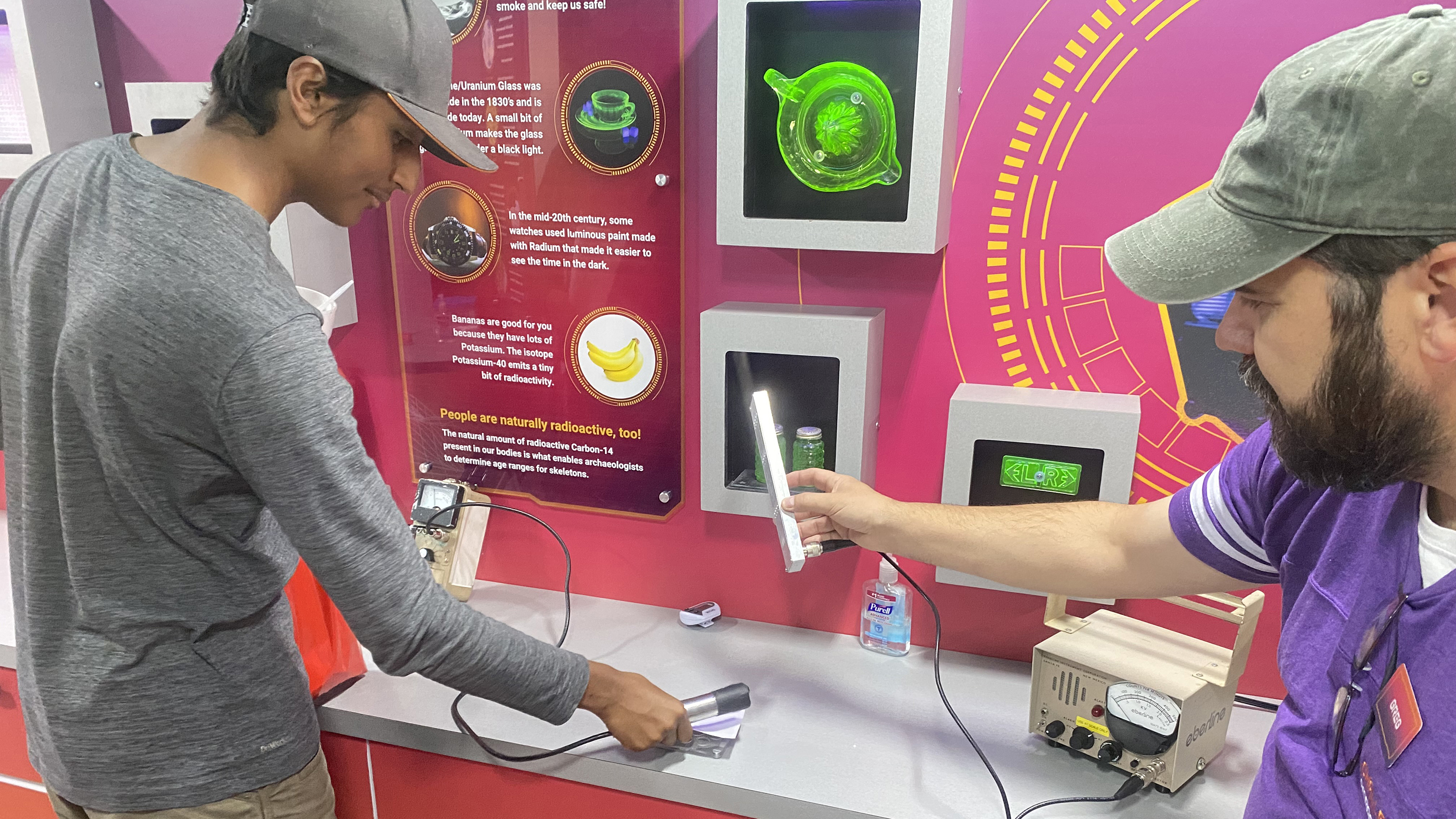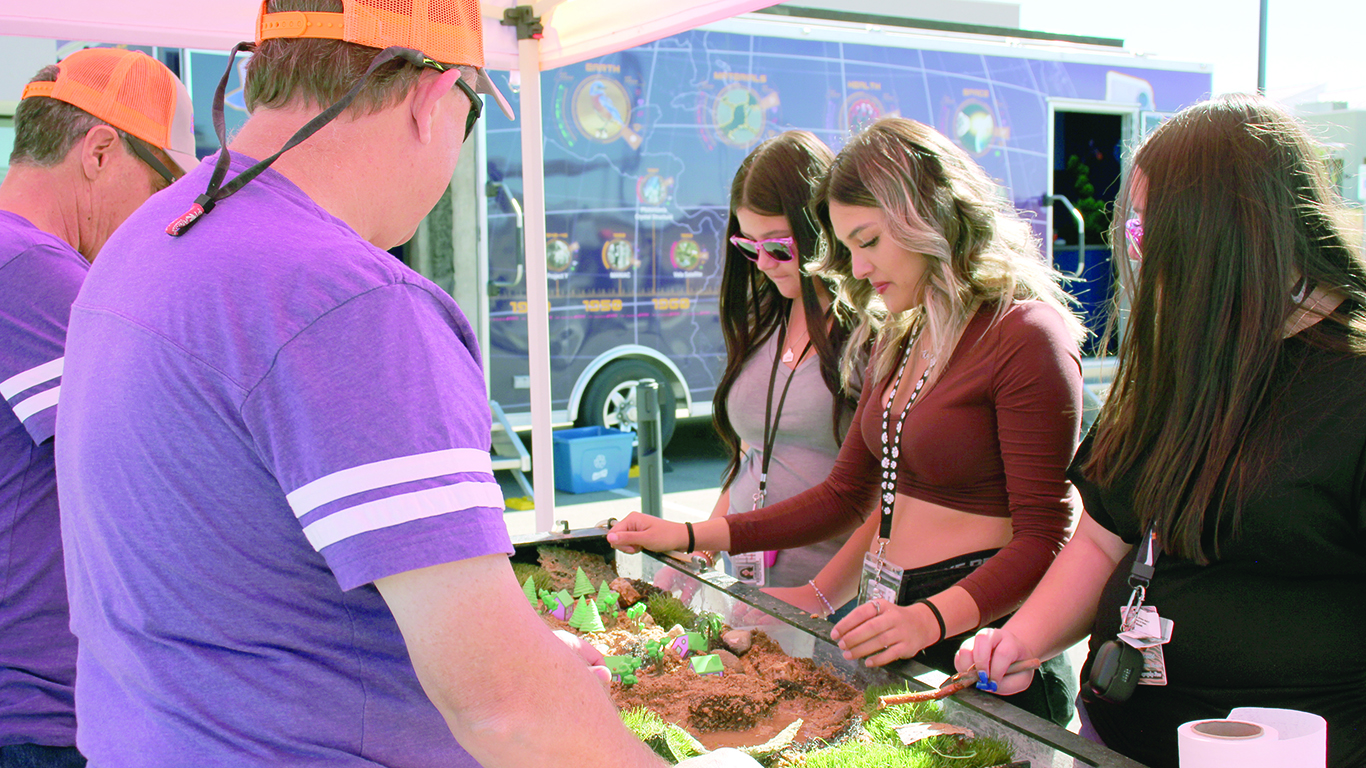LANL’s Traveling Interactive STEM Experience Visits UNM-Taos
October 25, 2023

Photo by Scott Gerdes
At the LANL radioactivity station, students could use devices that detect trace, safe amounts of radiation in everyday objects.
When it comes to getting middle and high school students interested in an education-related event, there’s nothing quite like throwing in some disease-related research equipment, a radioactivity detection device, and a Mars rover simulator to pique their curiosity.
Thanks to those science stations, and others, enthusiasm and engagement ran high among the local high school students who entered the Los Alamos National Laboratory (LANL) Challenge Tomorrow trailers, talked with LANL mentors and UNM-Taos Admissions staff, and attended STEM presentations held at Klauer campus on Oct. 19 and 20.
Middle- and high-schoolers are who LANL’s Discovery and Mission Ops trailers were designed for, and the students’ positive reactions were precisely what organizers Kat Cook, Challenge Tomorrow program coordinator and UNM-Taos K-12 Outreach Program Director Paralee King, anticipated.
“These trailers introduce students to and get them excited about STEM and associated careers,” Cook said. “They soak up the hands-on activities. We’re not lecturing them. We want them to ask questions and explore.”
And explore they did. With Challenge Ambassadors — volunteers made up of actual LANL employees — clearly explaining their stations, and how to interact with them and standing by for any questions, the students were free to experiment.
A station in the Discovery trailer focused on disease research, in which students could handle pipettes and other associated lab tools to simulate how a scientist would use them — using colored water, of course. The space station featured a simulator that students controlled to pan around a screen showing what can be seen on Mars. This station also had a 3D-printed model of the actual camera design used on a Mars rover.
Another section in this trailer highlighted the nanotechnology that goes on in a lab. It featured fake quantum dots (QDs), which are man-made nanoscale (extremely small) crystals that have unique optical and electronic properties. They’re used in drug delivery, live imaging and medical diagnosis, in addition to other applications beyond medicine such as in solar cells. LANL is currently doing research on QDs, Cook said. The final station addressed Earth, focusing on climate change and archaeology.
The Mission Ops trailer also had a health system station, which showed how scientists grow cells in their labs. How to stay safe from radioactivity with a display of safety clothes they could try on and how to use devices that detect trace, safe amounts of radiation in everyday objects were also featured.
“All of the radioactivity activities are toned-down versions of the real thing,” Cook explained as she swept a detecting wand over her forearm and it gave a brief, light beep. “None of it is dangerous in here. This is just to show the kids that even trace amounts of radiation can show up in many things. Even bananas naturally have minute amounts of it.”
An extra activity set up outside between the trailers was a student favorite, according to Cook. Simulating stormwater management, participants placed small plastic homes and trees in a sand-filled rectangular, tilting water table, and then staff flooded it. Students then had to figure out how to divert the water from rushing into the “neighborhood.” To save the homes, they strategically used their fingers to create trenches and placed rocks, sticks, fake turf, and mesh ground reinforcements to divert the water.
Outside of the Mission Ops trailer, students could move wooden blocks with an enclosed robotic arm — a coin-op claw machine on steroids, which is used to manipulate materials without direct physical contact by the operator.
Next to that was a laboratory glove box, which is a sealed enclosure designed to create and maintain an environment where the air inside is filtered and replaced with sterile air. This allows for sensitive operations to be carried out without contamination.
Cook said the Challenge Tomorrow trailers have been in high demand since their launch in February 2022. They came to be during the height of COVID, after LANL Director Thom Mason wondered why LANL didn’t have educational travel trailers like they did while serving in his previous post at Oak Ridge National Laboratory in Tennessee. The popular trailers serve seven counties around Los Alamos, including Taos County.
The Challenge Tomorrow trailers were also on Klauer campus during the Oct. 21 Howl-o-ween Fall Fest and Open House community event.

